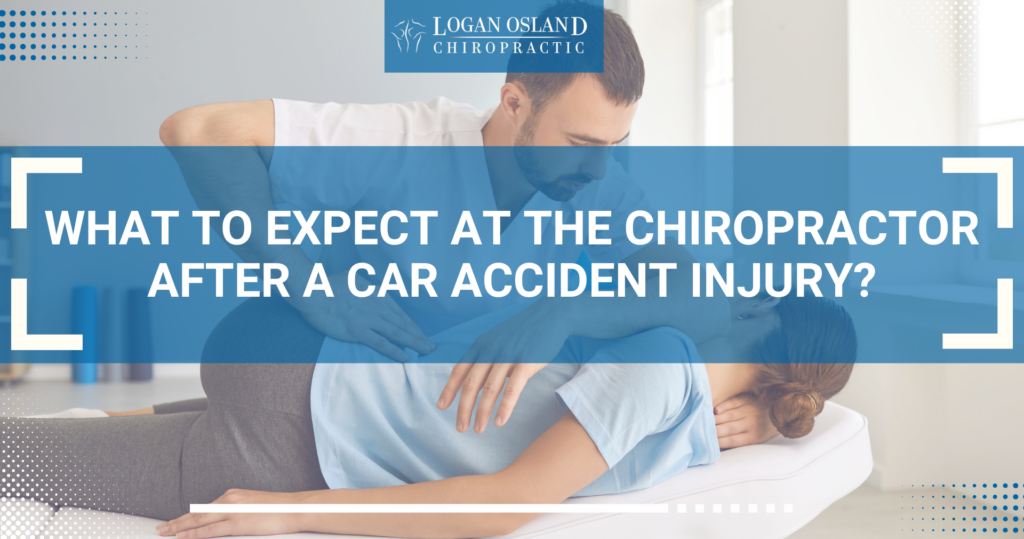If you’ve recently been in a car accident, you probably feel stiff, sore, or even experiencing pain that wasn’t there immediately after the crash. Many people assume that only high-impact collisions cause serious injuries, but even minor fender benders can lead to significant issues, especially when it comes to the spine, soft tissues, and overall mobility.
In fact, some of the most common accident-related injuries, like whiplash or spinal misalignment, may not present symptoms until days or even weeks later, making early evaluation and treatment essential.
I’ve seen many times that something that starts as mild discomfort develops into chronic pain, making prompt chiropractic care so important. We must prevent those long-term complications.
In this guide, I’ll walk you through exactly what happens when you visit a chiropractor after a car accident. We’ll cover everything from your initial assessment to how we address different types of injuries.
Car Accident Injuries
Car accidents, whether they are major collisions or minor ones, can cause a wide range of injuries. Even if you don’t feel intense pain right after the accident, it’s important to remember that injuries sometimes manifest over time and have long-lasting effects.
These are some of the most common injuries that chiropractors treat after a car accident:
- Whiplash and Neck Injuries: Whiplash is probably the most common auto accident injury. When the vehicle suddenly stops or changes direction, the head jerks forward and backward rapidly, putting significant strain on the neck’s muscles, ligaments, and soft tissues. This motion causes sprains, strains, or even ligament tears. Whiplash injury triggers pain, stiffness, headaches, and a decreased range of motion in the neck region of accident victims.
- Back Pain and Spinal Misalignments: The force of a car accident jolts the body, often shifting spinal vertebrae out of their proper alignment. This misalignment, also known as a subluxation, can lead to chronic back pain, limited mobility, and nerve compression. Untreated misalignments lead to sciatica or degeneration of the spinal discs.
- Soft Tissue Injuries and Muscle Strains: The sudden force of a car crash can strain the muscles, tendons, and ligaments throughout the body. Soft tissue injuries are often overlooked, but they are still tricky to solve. You don’t want that pain, swelling, and bruising to become worse.
- Herniated or Bulging Discs: From time to time, a car accident leads to a herniated or bulging disc in the spine. The impact of the crash may push the discs out of their natural position.
- Shoulder and Joint Injuries: During a car accident, the body may tense up, or the arms may be thrown against the steering wheel or seatbelt. Shoulders, elbows, knees, and other joints suffer the most.
- Headaches and Dizziness: Headaches and dizziness are commonly experienced after a car accident, especially if the neck or spine is injured. Whiplash, in particular, triggers tension headaches, migraines, or vertigo.
How Chiropractic Care Addresses These Injuries?
Unlike medication, which only masks pain temporarily, chiropractic care fixes on treating the root cause.
Spinal Adjustments
Chiropractors use spinal adjustment to manipulate the vertebrae back into their proper position, reducing pressure on the nerves and alleviating pain. This realignment restores the natural curve of the spine and improves nervous system function.
Soft Tissue Therapy
Massage, myofascial release, physical therapy, and trigger point therapy release tension and promote blood flow to the affected areas. These therapies help in healing. Soft tissue therapy is particularly effective for treating whiplash, muscle strains, and ligament sprains.
Corrective Exercises
These exercises focus on improving flexibility, strength, and stability, which are key to restoring full function and preventing future injuries. Strengthening the muscles around the spine, neck, or other affected joints helps protect them from additional strain and instability.
Postural Corrections
Poor posture can exacerbate existing pain. Auto accident chiropractor assesses and corrects postural imbalances caused by the accident. Postural corrections are part of a wider medical treatment plan to restore your body’s natural alignment.
What to Expect at Your First Chiropractic Appointment After a Car Accident Injury?
On your first visit, we’ll start by discussing what happened during the accident. I’ll ask about your symptoms, when they started, and whether they’ve worsened. Even if you don’t feel much pain right away, it’s important to get checked.
Next, I’ll perform a thorough evaluation to pinpoint any injuries. This includes:
- Checking spinal alignment and posture.
- Testing your range of motion.
- Assessing neurological responses (like reflexes and sensation).
- Palpating soft tissues for areas of tightness or tenderness.
If I suspect a more serious issue (like a herniated disc or fracture), I may recommend X-rays or, in some cases, an MRI. Just to make sure we have a full picture of what’s happening internally.
Once we have a clear understanding of your condition, we’ll discuss a customized care plan. I’ll explain the findings in detail, outline recommended treatments, and give you an idea of how long recovery might take based on the severity of your injuries.
Step-by-Step Chiropractic Treatment Process for Car Accident Recovery
During the early stages of recovery (phase 1), our goal is to reduce pain and inflammation. Treatment may include:
- Gentle spinal adjustments to relieve nerve pressure.
- Ice/heat therapy to reduce swelling.
- Soft tissue mobilization to break up tension and promote blood flow.
Phase 2: Restoring Mobility and Function
Once we provide pain relief, we shift focus to improving movement. This stage typically involves:
- Targeted spinal chiropractic adjustment to restore normal function.
- Stretching techniques to increase flexibility.
- Postural training to correct imbalances caused by the accident.
Phase 3: Strengthening and Preventing Future Issues
To ensure long-term healing, we move into rehabilitation. This phase includes:
- Corrective exercises to strengthen stabilizing muscles.
- Core strengthening movements to support spinal health.
- Lifestyle recommendations to prevent recurring pain.
How Severity of Your Injuries Affects Chiropractic Treatment?
The severity of your injuries plays a significant role in determining the chiropractic approach and the expected recovery timeframe.
Mild Injuries (Soreness, Stiffness, Minor Whiplash)
These injuries usually resolve within a few weeks. Chiropractic care for mild injuries involves gentle spinal manipulation, light stretching, and soft tissue therapy. The goal is to reduce inflammation and speed up healing.
Moderate Injuries (Whiplash, Muscle Strains, Disc Issues)
Recovery for these injuries typically takes a few months, and treatment focuses on addressing the underlying causes of pain and dysfunction. A combination of regular chiropractic adjustments, rehabilitation exercises, and possibly spinal decompression therapy is often used to relieve pressure on the spine and muscles.
Severe Injuries (Herniated Discs, Chronic Pain, Nerve Damage)
Those ones usually don’t go away even after three months, but need even more to heal. Such injuries also often require ongoing maintenance care to manage symptoms and maintain function. Chiropractic care for severe injury may include intensive therapy, nerve function assessments, and working in collaboration with medical specialists.
Final Thoughts
Waiting for the pain to go away after a car accident is not a good approach. You need to take proactive steps to heal correctly. Chiropractic care is exactly what you need. It is a natural, non-invasive solution that helps the body recover while preventing long-term issues from developing.
If you or someone you know has been in a car or truck accident, don’t wait for symptoms to worsen. Seeking care early can make all the difference in how well and how quickly you recover. Schedule an appointment, and let’s get you back to feeling your best.
Frequently Asked Questions About Car Accident Injuries
Can chiropractic care help with concussion-related symptoms after a car accident?
Chiropractic care can support concussion recovery by improving spinal alignment and reducing nerve interference. While chiropractors do not directly treat concussions, adjustments to the cervical spine may help relieve headaches, dizziness, and tension caused by the personal injury.
Do I need a referral from a doctor to visit a chiropractor after a car accident?
You don’t need a referral to see a car accident chiropractor. Chiropractors are primary care providers, meaning you can schedule an appointment directly. However, if you’re filing an insurance claim, check with your provider about any specific requirements.
Can a chiropractor diagnose hidden injuries that don’t show symptoms immediately?
Yes, chiropractors are trained to identify injuries that may not cause back or neck pain right away. Through spinal assessments, range of motion tests, and imaging if needed, they can detect misalignments, soft tissue damage, or nerve issues before they worsen.
What lifestyle changes or at-home exercises can support chiropractic treatment after a car accident?
Staying active with gentle movement, maintaining good posture, and doing prescribed stretching exercises aid recovery. Avoiding prolonged sitting, using ice or heat therapy as needed, and following your chiropractor’s recommendations will boost healing.
Is chiropractic care safe for older adults or children who were in a car accident?
Chiropractic treatment is safe and effective for both older adults and children. Pediatric and senior chiropractic techniques are gentle and can help significantly.
References
Dies S, Strapp JW. Chiropractic treatment of patients in motor vehicle accidents: a statistical analysis. J Can Chiropr Assoc. 1992 Sep;36(3):139–45. PMCID: PMC2484939.
Alghnam S, Palta M, L Remington P, Mullahy J, S Durkin M. The association between motor vehicle injuries and health-related quality of life: a longitudinal study of a population-based sample in the United States. Qual Life Res. 2014 Feb;23(1):119-27. doi: 10.1007/s11136-013-0444-3. Epub 2013 Jun 6. PMID: 23740168; PMCID: PMC6546419.
Ferrando J, Plasència A, Ricart I, Canaleta X, Seguí-Gómez M. Motor-vehicle injury patterns in emergency-department patients in a south-European urban setting. Annu Proc Assoc Adv Automot Med. 2000;44:445-58. PMID: 11558100; PMCID: PMC3217388.


